How to Dehydrate Bell Peppers
This post may contain affiliate links.
Dehydrated bell peppers are an unbelievably versatile staple to have in your pantry. Whether you’re a home cook, car camper, or backpacker, a jar of dehydrated peppers is an easy way to add colorful vegetables to just about any meal!
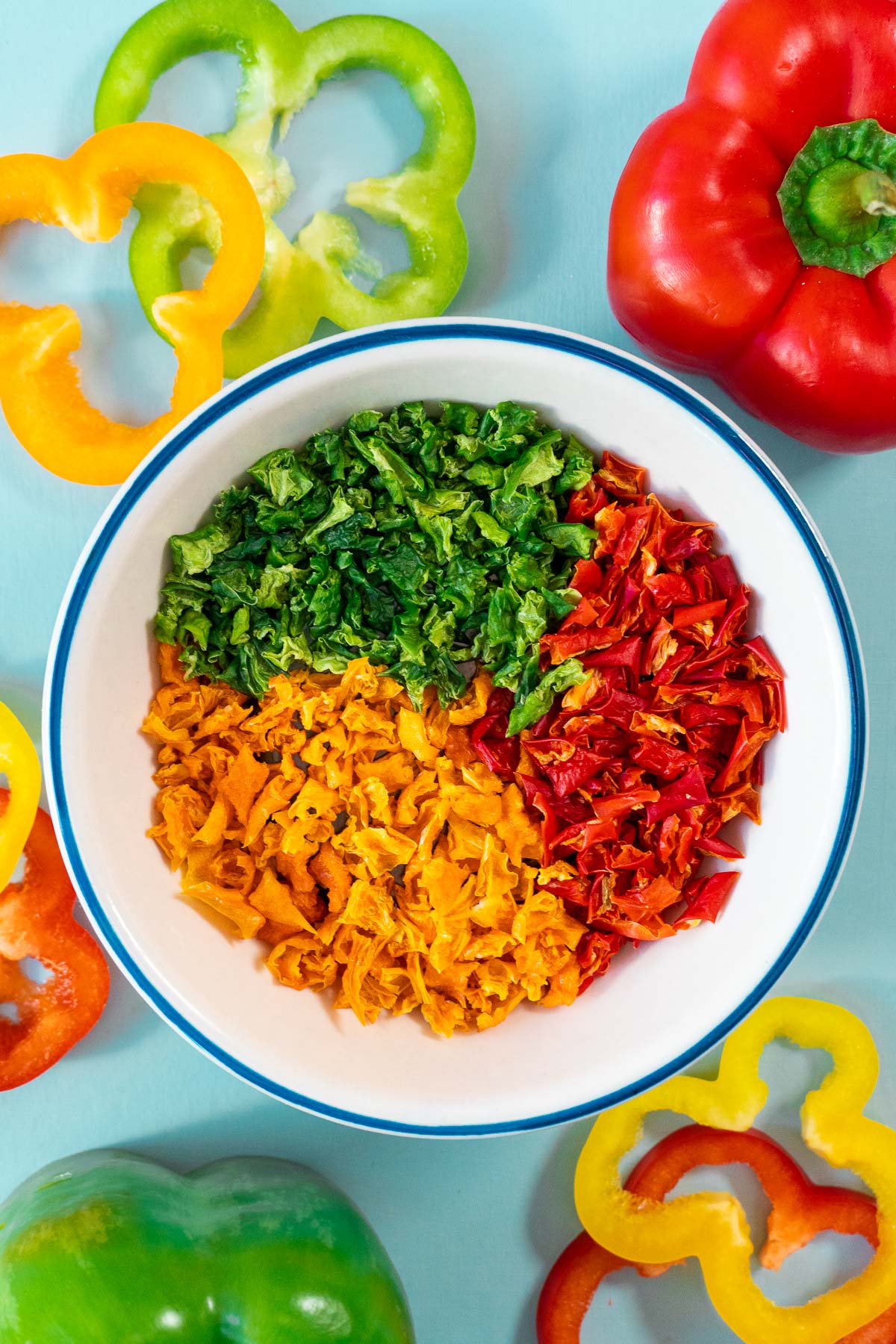
Red, orange, yellow, or green, we love the bright and festive energy dehydrated bell peppers bring to a meal. They’re like the vegetable version of sprinkles!
While fresh bell peppers are available at the grocery store year-round, it can be really nice to have a jar of shelf-stable dehydrated bell peppers on hand in the pantry. The bite-sized dehydrated pieces just need a little bit of time in hot water to rehydrate, which means they can be spontaneously added to a lot of different meals.
We add them when making rice for paella, pasta when making chili mac, sauces like bolognese or marinara, or just about any type of braise. Anything where you will be cooking something in hot water for a little bit. And when you have dehydrated peppers in the pantry, adding some vegetables can become as easy and casual as adding some salt.
We also love to use dehydrated bell peppers for backpacking. They’re amazing in all sorts of cold-soaked pasta lunches as well as lightweight dinners like our quinoa burrito bowl.
Okay, have we sold you on how great dehydrated bell peppers are yet? Great, now let’s show you how easy it is to make them yourself!
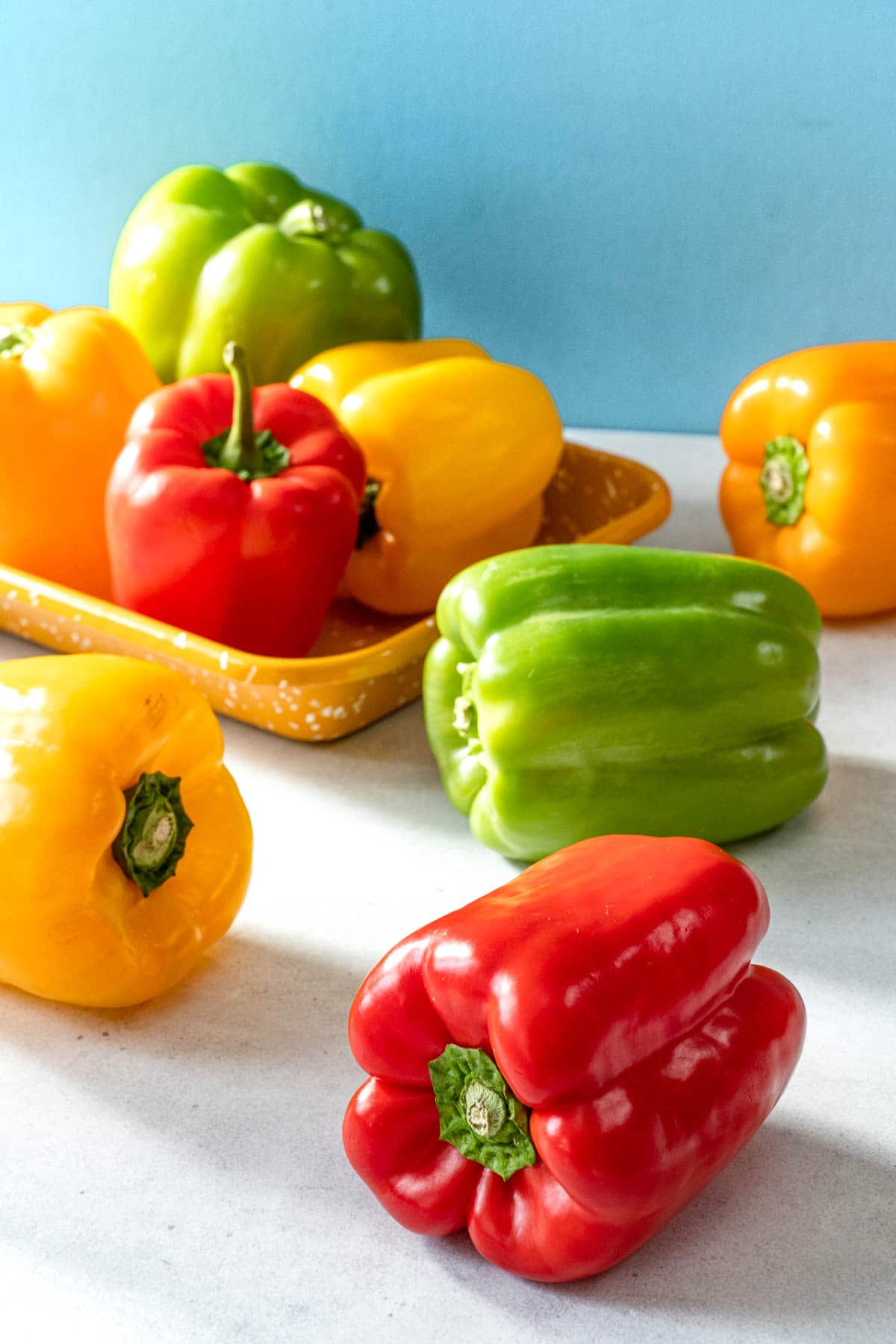
What types of bell peppers can be dehydrated?
You can dehydrate any color of bell pepper! Red, orange, and yellow peppers will be slightly sweeter and more “fruity” than green bell peppers due to the higher sugar content that develops as the pepper matures.
Choose organic peppers if possible, as bell peppers are one of the “dirty dozen” more likely to contain pesticide residues.
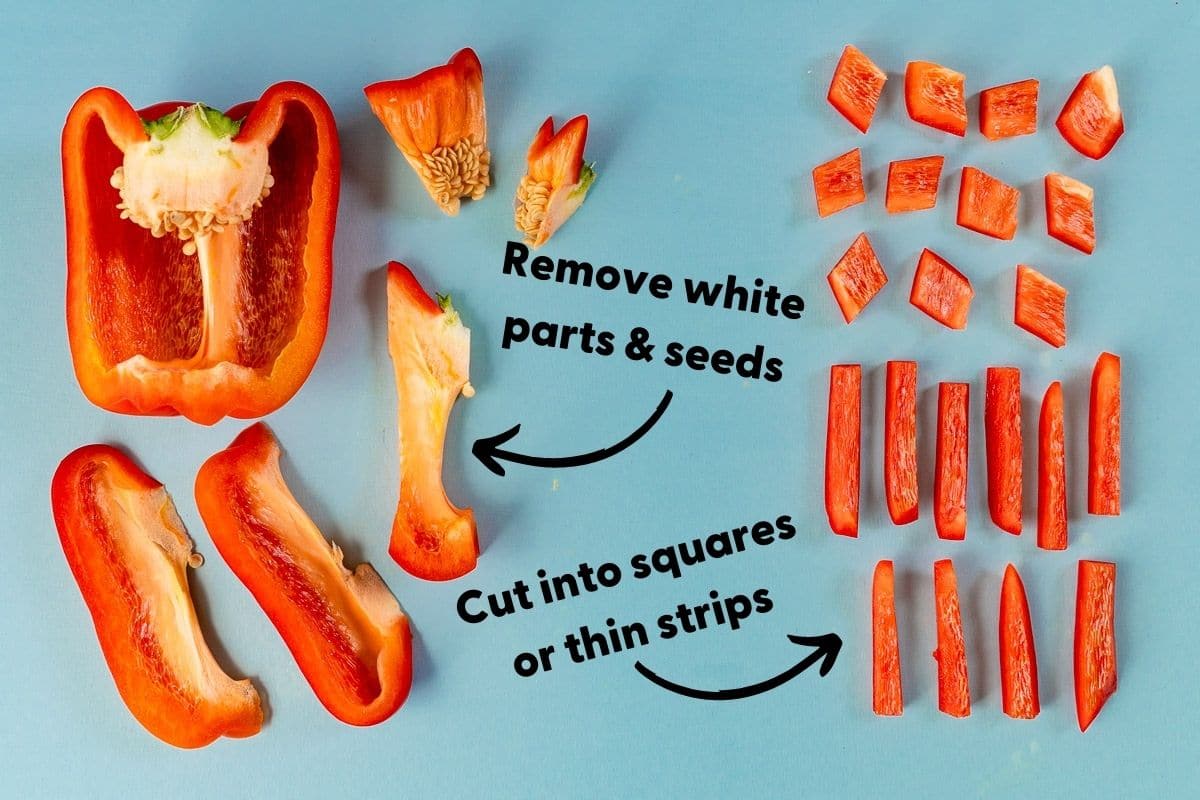
Prepping & pretreating bell peppers for dehydrating
- Clean the bell peppers: Thoroughly wash the peppers and dry with a towel.
- Remove the stems, seeds, and white ribs and discard.
- Slice the bell peppers: Using a sharp knife, cut the bell peppers into ¼” to ½” squares, or into thin strips. You can also slice them into thin rounds. Try to keep the pieces to a uniform size to help with even drying.
- If you’re dehydrating bell peppers for backpacking meals, note that while it’s not necessary, it will rehydrate faster if blanched or steamed. To blanch, bring a pot of water to a boil and add the sliced or chopped bell peppers. Blanch for four minutes before straining out the peppers and placing them in an ice bath or running under very cold water to stop the cooking process. Drain and dry.
Equipment Spotlight: Dehydrators
If you’re in the market for a dehydrator, we recommend buying one with an adjustable temperature. This will allow you to dial in the drying temp to give you the best results for individual ingredients. The dehydrator we recommend (and use) most often is the COSORI dehydrator. You can also check out our best dehydrators post for a comparison of all the dehydrators we’ve used and would recommend.
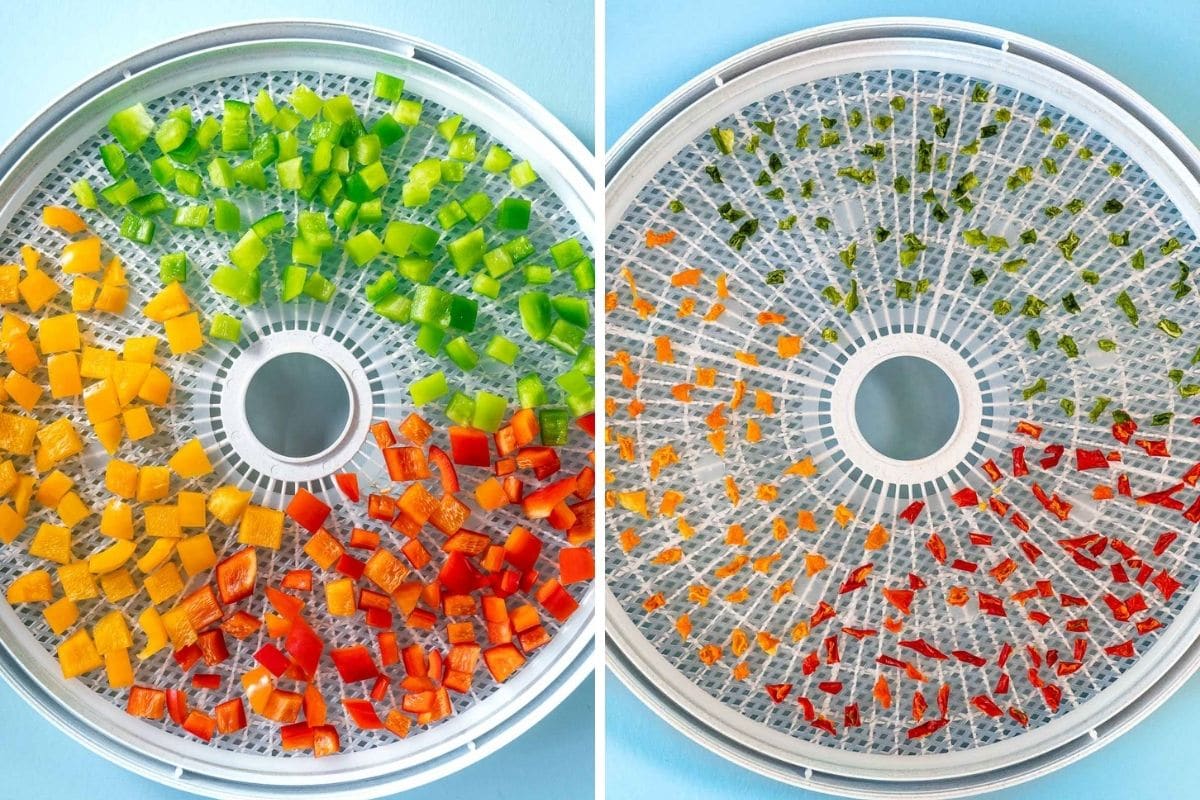
How to dehydrate bell peppers
Dehydrating bell peppers is fairly simple and straightforward—a great ingredient for beginners! Once your counters, equipment, and hands are clean, set up your dehydrator and follow these steps:
- Arrange the bell peppers on your dehydrator trays. If you’re using a tray that has large holes, line it with parchment paper or, even better, a mesh liner cut to the size of your tray (be aware that bell peppers may stain the mesh). Leave space between the pieces to allow air to circulate.
- Dehydrate at 125ºF (52ºC) for 8-12 hours until the bell peppers are dry and hard—they should not be pliable or bend.
- Depending on your machine, you may need to rotate the trays every so often to promote even drying.
How to tell when bell peppers are done
Bell peppers should be hard when they are completely dried. To test, let them cool, then try to bend a few pieces. If they bend, put them back into the dehydrator or oven to dry longer.
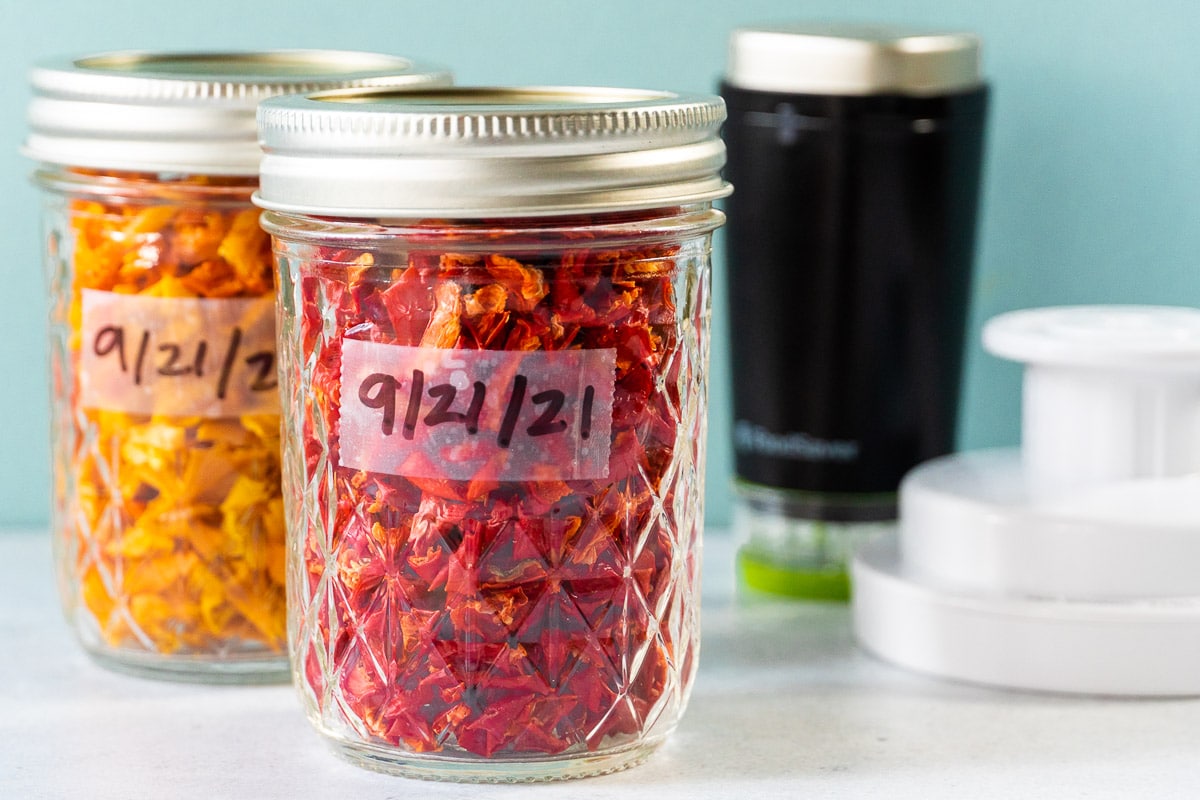
How to store
When properly dried and stored, dehydrated bell peppers can last upwards of a year. Here are our tips for storage:
- Let the bell peppers cool completely before transferring them.
- Condition: Loosely pack the peppers in a transparent airtight container. Check it daily for a week to check for signs of moisture or condensation, and shake to help prevent the pieces from sticking together. If signs of moisture appear, stick them back into the dehydrator (as long as there’s no mold—in that case, toss the batch). After a week, if there’s no signs of moisture or mold, you can package them for long-term storage.
- Store in a clean, airtight container. For longer shelf life, vacuum seal.
- Use a moisture absorbing desiccant packet if you anticipate opening the container often, or if you live in an area with high humidity.
- Label the container with the date and any other important details
- Place the container in a cool, dark, and dry place—inside of a pantry cabinet works well.
Vacuum Sealing Tips
We like to store our dehydrated food in mason jars that have been vacuum-sealed using this handheld FoodSaver vacuum sealer along with these jar sealing attachments. This gives us the benefit of vacuum sealing without the waste (and expense) of plastic vacuum sealing bags. Since the jars are clear we make sure we store them in a dark spot in our pantry to keep them out of direct light.
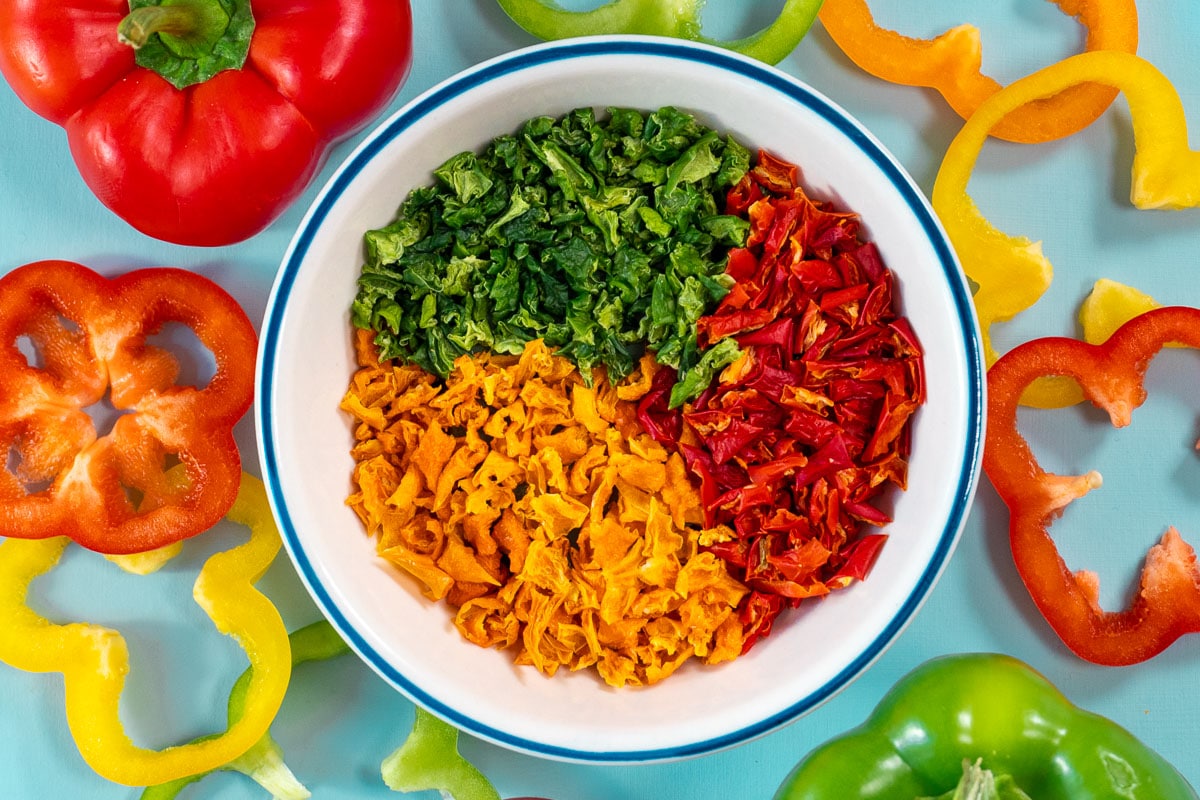
How to use
To rehydrate dried bell peppers, cover in boiling water for 15-20 minutes, or add directly into dishes that are liquidy and will cook for a bit, such as chili.
Here are a few ways to use your bell peppers:
- Add to chili, soups, or casserole dishes
- Rehydrate and add to pastas, pasta salad, veggie couscous or quinoa
- Rehydrate and add to ground taco meat
- Toss them in with Spanish rice or paella
- Add to homemade marinara sauce
- Turn them into powder and use as a seasoning or in dry rubs and marinades
- Use them in these backpacking/camping meals:
Fresh to dehydrated conversion
1 bell pepper (1 cup chopped) = 3 tablespoons dried bell pepper (about 10g)
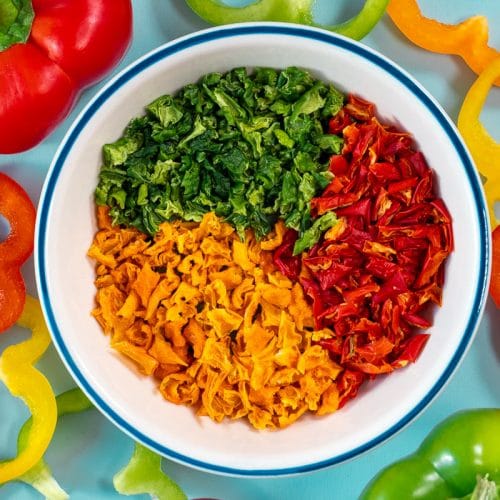
Dehydrated Bell Peppers
Equipment
- Airtight storage container
- Vacuum sealer (optional)
Ingredients
- Bell peppers, see note 1
Instructions
- Start with clean hands, equipment, and countertops.
- Prep the bell peppers—remove and discard the top, white ribs, and seeds. Cut into ¼” to ½” squares, or into thin strips.
- Optional: Blanch if desired. Bring a pot of water to a boil and add the sliced or chopped bell peppers. Blanch for four minutes before straining out the peppers and placing them in an ice bath or running under very cold water to stop the cooking process. Drain and dry.
- Arrange the bell peppers on dehydrator trays, utilizing a mesh liner to prevent the peppers from falling through the holes as it shrinks.
- Dehydrate at 125ºF (52ºC) for 6-12 hours until the bell peppers are is dry and hard—they should not bend (see note 2).
Storage Tips
- Let the dried bell peppers cool completely before storing.
- Short term storage: If bell peppers will be consumed within a few weeks, store in a ziptop bag or sealed container on the counter or in a pantry.
- Long-term storage: Condition by loosely packing the dried bell peppers in a transparent, airtight container. Leave it on the counter for a week and check it daily for signs of moisture. If condensation appears, return the bell pepper to the dehydrator (unless there are signs of mold—then, throw out the whole batch). Shake occasionally to keep the pieces from sticking together.
- After conditioning, store in an airtight container in a cool, dark place for up to a year. Vacuum sealing will help extend the shelf life and quality of the bell pepper.
